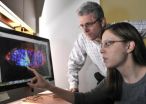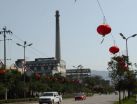(Press-News.org) Resistance is not futile when it comes to a new method to more efficiently convert biomass to biofuels.
New research by scientists from Lawrence Livermore National Laboratory in conjunction with the Joint BioEnergy Institute (JBEI) suggests that a type of bacterial resistance may provide more efficient production of biofuels.
The team identified the genetic origin of bacterial resistance to an ionic liquid (a salt in the liquid state), which they successfully introduced into a strain of E. coli bacteria for the production of advanced biofuels. The ionic liquid resistance is based on a pair of genes discovered in a microbial species native to a tropical rainforest in Puerto Rico.
"Ionic liquids are used as potent solvents to extract cellulose from biomass, so that it can be broken down to sugars used by microbes to make advanced biofuels – new liquid fuels that go beyond ethanol and can replace gasoline or diesel," said Michael Thelen, an LLNL biochemist who also is part of JBEI's Deconstruction Division.
The team identified two genes in Enterobacter lignolyticus, a rainforest soil bacterium that is tolerant to specific ionic liquids, and transferred them as part of a genetic module into an E. coli biofuel host. The genetic module conferred the tolerance needed for the E. coli to grow well in the presence of toxic concentrations of ionic liquids. As a result, production of a terpene-based biofuel was enhanced.
The research appears in the March 26 edition of the journal, Nature Communications.
At JBEI, researchers have previously engineered strains of E. coli bacteria to digest the cellulosic biomass of switchgrass, a perennial grass that thrives on land not suitable for food crops, and convert its sugars into biofuels and chemicals. However, the ionic liquids used to make the switchgrass digestible proved to be too toxic for the E. coli and had to be completely removed through several washings prior to fermentation.
"The new genes confer to E. coli the ability to grow in the presence of normally toxic levels of an ionic liquid, making it possible to produce biofuels more efficiently," Thelen said. "The consequences of this study pave the way for further improvements in the microbial conversion of biomass to biofuels."
In this latest study, JBEI researchers used an approach devised by lead author and Basel University graduate student and LLNL guest researcher Thomas Ruegg to rapidly pinpoint the genes responsible for ionic liquid resistance in the genomic DNA of Enterobacter lignolyticus. "This genetic module encodes both a membrane transporter and its transcriptional regulator," Ruegg said. "While a pump exports ionic liquids, the substrate-inducible regulator maintains the appropriate level of this pump so that the microbe can grow normally either in the presence or absence of ionic liquid."
The results are likely to eliminate a bottleneck in JBEI's biofuels production strategy, which relies on ionic liquid pretreatment of cellulosic biomass. The research also demonstrates how the adverse effects of ionic liquids can be turned into an advantage, by inhibiting the growth of other bacteria. This research was funded by the DOE Office of Science.
INFORMATION:
Founded in 1952, Lawrence Livermore National Laboratory provides solutions to our nation's most important national security challenges through innovative science, engineering and technology. Lawrence Livermore National Laboratory is managed by Lawrence Livermore National Security, LLC for the U.S. Department of Energy's National Nuclear Security Administration.
Lawrence Livermore scientists discover bacterial resistance to improve biofuel production
2014-03-26
ELSE PRESS RELEASES FROM THIS DATE:
Significant progress toward creating 'benchtop human' reported
2014-03-26
Significant progress toward creating "homo minutus" - a benchtop human -was reported at the Society of Toxicology meeting on Mar. 26 in Phoenix.
The advance - successful development and analysis of a liver human organ construct that responds to exposure to a toxic chemical much like a real liver- was described in a presentation by John Wikswo, the Gordon A. Cain University Professor and Director of the Vanderbilt Institute for Integrative Biosystems Research and Education (VIIBRE) at Vanderbilt University.
The achievement is the first result from a five-year, $19 million ...
UT Southwestern cancer biologists link tumor suppressor gene to stem cells
2014-03-26
DALLAS – March 26, 2014 – Just as archeologists try to decipher ancient tablets to discern their meaning, UT Southwestern Medical Center cancer biologists are working to decode the purpose of an ancient gene considered one of the most important in cancer research.
The p53 gene appears to be involved in signaling other cells instrumental in stopping tumor development. But the p53 gene predates cancer, so scientists are uncertain what its original function is.
In trying to unravel the mystery, Dr. John Abrams, Professor of Cell Biology at UT Southwestern, and his team ...
Biological testing tool, ScanDrop, tests in fraction of time and cost of industry standard
2014-03-26
Northeastern University professor of pharmaceutical sciences, Tania Konry, has developed a single instrument that can conduct a wide range of biological scans in a fraction of the time and cost of industry standard equipment. That's because it uses considerably less material and ultra-sensitive detection methods to do the same thing.
Currently, researchers face enormous time constraints and financial hurdles from having to run these analyses on a regular basis. Hundreds of dollars and 24 hours are what's required to scan biological materials for important biomarkers that ...
Natural history must reclaim its place
2014-03-26
Support in developed countries for natural history—the study of the fundamental nature of organisms and how and where they live and interact with their environment—appears to be in steep decline. Yet natural history provides essential knowledge for fields as varied as human health, food security, conservation, land management, and recreation. In the April issue of BioScience, a group of scientists from institutions across North America details examples supporting their conviction that a revitalization of the practice of natural history will provide important benefits for ...
Coal plant closure in China led to improvements in children's health
2014-03-26
Decreased exposure to air pollution in utero is linked with improved childhood developmental scores and higher levels of brain-derived neurotrophic factor (BDNF), a key protein for brain development, according to a study looking at the closure of a coal-burning power plant in China led by researchers at the Columbia Center for Children's Environmental Health at the Mailman School of Public Health.
The study is the first to assess BDNF and cognitive development with respect to prenatal exposure to polycyclic aromatic hydrocarbons (PAH), a component of air pollution commonly ...
Resistance is not futile
2014-03-26
Researchers with the U.S. Department of Energy (DOE)'s Joint BioEnergy Institute (JBEI), a multi-institutional partnership led by Berkeley Lab, have identified the genetic origins of a microbial resistance to ionic liquids and successfully introduced this resistance into a strain of E. coli bacteria for the production of advanced biofuels. The ionic liquid resistance is based on a pair of genes discovered in a bacterium native to a tropical rainforest in Puerto Rico.
"We identified two genes in Enterobacter lignolyticus, a soil bacterium that is tolerant to imidazolium-based ...
NASA catches Gillian as a super-cyclone before quickly dissipating
2014-03-26
VIDEO:
On March 23 when the TRMM satellite passed over Gillian, it was at hurricane-force. TRMM revealed intense storms in a well-defined eye wall producing rain at a rate of over...
Click here for more information.
Tropical Cyclone Gillian was near peak intensity when the Tropical Rainfall Measuring Mission or TRMM satellite passed overhead and saw towering thunderstorms and very heavy rainfall in the storm on March 23. By March 26, Gillian had weakened to a tropical storm and ...
Rice U. study: Don't shop for travel at work
2014-03-26
HOUSTON – (March 26, 2014) –It is probably not a good idea to shop for leisure travel from the office during business hours, according to a new study from Rice University and Iowa State University.
Using data from a major online hotel reservation site, the study examined the quality of the hotel that consumers chose for their vacations and subsequently how satisfied they were with their stay. They found that consumers who traveled farther and made reservations during business hours were more likely to select higher quality hotels but were less satisfied after their stay. ...
Dark energy hides behind phantom fields
2014-03-26
Quintessence and phantom fields, two hypotheses formulated using data from satellites, such as Planck and WMAP, are among the many theories that try to explain the nature of dark energy. Now researchers from Barcelona and Athens suggest that both possibilities are only a mirage in the observations and it is the quantum vacuum which could be behind this energy that moves our universe.
Cosmologists believe that some three quarters of the universe are made up of a mysterious dark energy which would explain its accelerated expansion. The truth is that they do not know what ...
Albert Einstein College of Medicine researchers present at AACR Annual Meeting symposia
2014-03-26
March 26, 2014 – (BRONX, NY) – From uncovering the role nerve cells play in metastasis to identifying new cancer-causing genes, researchers at Albert Einstein College of Medicine of Yeshiva University made notable advances in the understanding and potential treatment of cancer during the past year.
Several Einstein faculty members and students will present their recent research at the American Association for Cancer Research (AACR) Annual Meeting, taking place in San Diego April 5-9, 2014. Among the presentations are those during major and mini symposia:
Gene Regulation ...






